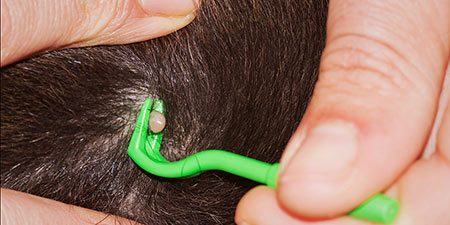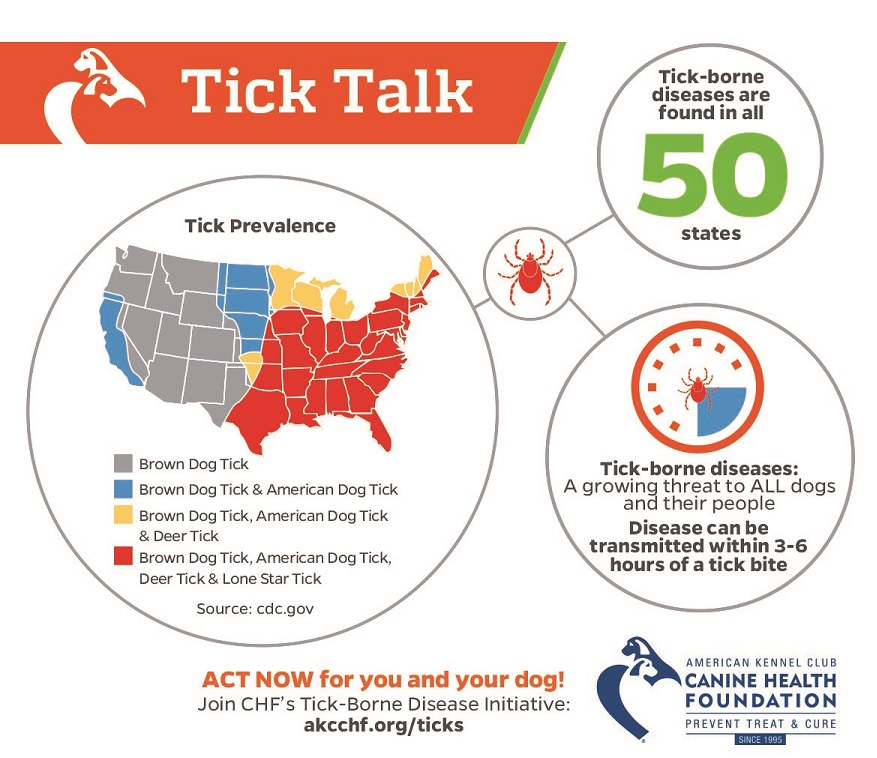AKC is a participant in affiliate advertising programs designed to provide a means for sites to earn advertising fees by advertising and linking to akc.org. If you purchase a product through this article, we may receive a portion of the sale.
Removing ticks from your dog may not be pleasant, but it’s important to do it promptly and correctly. Once you know how to remove a tick, it will be a fairly easy process.
Because they can carry infectious organisms, ticks infect thousands of animals and people with illnesses like Lyme disease, babesiosis, and ehrlichiosis every year. Pathogen transmission can occur as quickly as three to six hours after a bite occurs, so the sooner you remove the tick, the less chance there is that your dog will get sick.
A tick has a one-piece body. The harpoon-like barbs of its mouth attach to a host for feeding. Crablike legs and a sticky secretion help hold the tick to the host. Ticks range in size from almost impossible to see with the naked eye, to ones the size of a human fingertip. The United States has about 200 tick species. They can survive—and thrive—in woods, beach grass, lawns, forests, and even urban areas. Ticks also aren’t picky eaters; they feed on mammals, birds, and even other insects.
Removing a Tick From Your Dog
Using a pair of tweezers is the most common and effective way to remove a tick. But not just any tweezers will work. Most household tweezers have large, blunt tips. You should use fine-point tweezers, to avoid tearing the tick and spreading possible infections into the bite area.
Spread your dog’s fur, then grasp the tick as close to the skin as possible. Very gently, pull straight upward, in a slow, steady motion. This will prevent the tick’s mouth from breaking off and remaining embedded in the skin. People often believe it’s the head of the tick that embeds in the skin. But ticks don’t have heads, in the conventional sense, so what gets inserted into your dog is known as “mouth parts.”
Another option that is even easier to master is the use of a tick removal hook. It’s especially useful if you live in a tick-dense area where your dog is frequently playing host to the vexing little critters. There are several types of hooks, like the Tick Tornado or the Tick Stick. You simply put the prongs on either side of the tick and twist upward.

Never remove a tick with your fingers—it’s not only ineffective, but the squeezing may also further inject infectious material.
After you’ve removed the tick, make sure to wash your hands thoroughly, clean the bite site with rubbing alcohol, and rinse the tweezers or tool with disinfectant.

This article is intended solely as general guidance, and does not constitute health or other professional advice. Individual situations and applicable laws vary by jurisdiction, and you are encouraged to obtain appropriate advice from qualified professionals in the applicable jurisdictions. We make no representations or warranties concerning any course of action taken by any person following or otherwise using the information offered or provided in this article, including any such information associated with and provided in connection with third-party products, and we will not be liable for any direct, indirect, consequential, special, exemplary or other damages that may result, including but not limited to economic loss, injury, illness or death.

